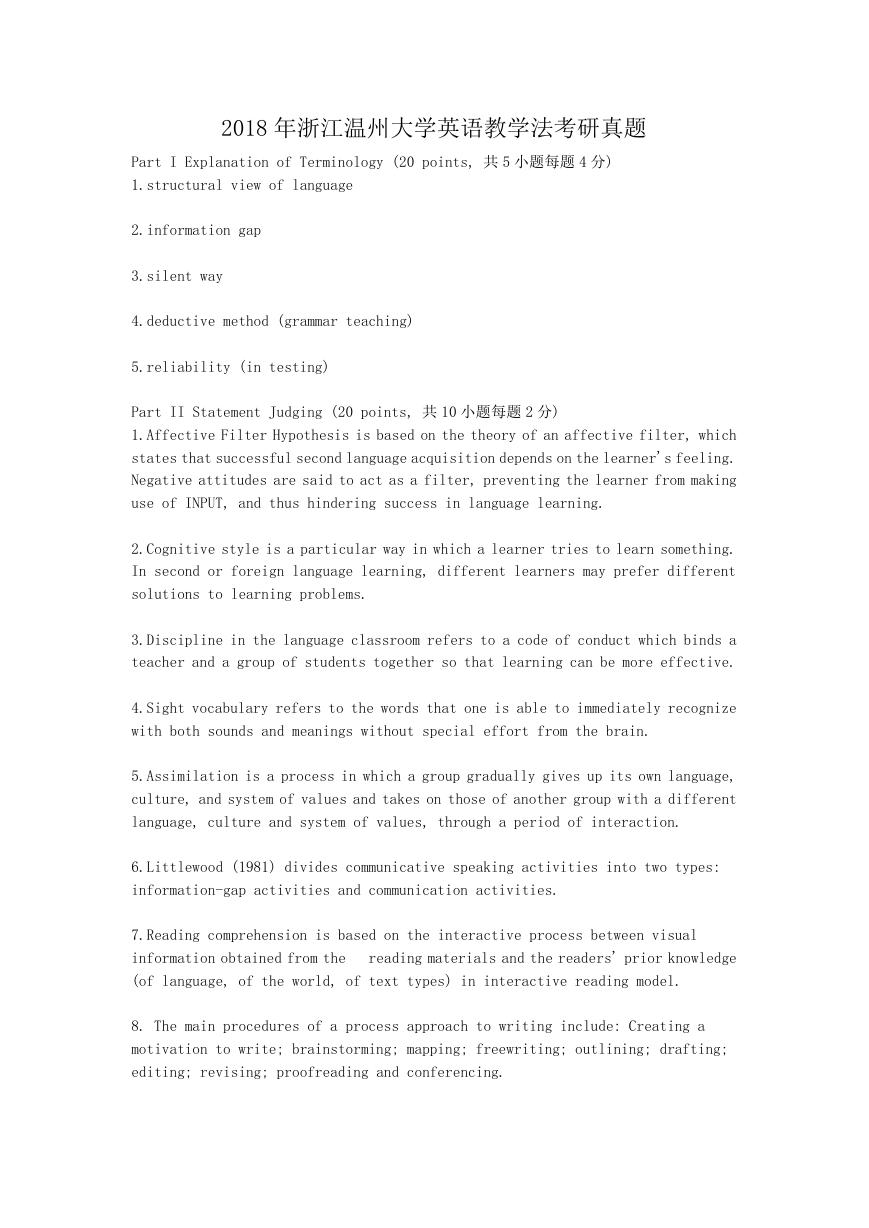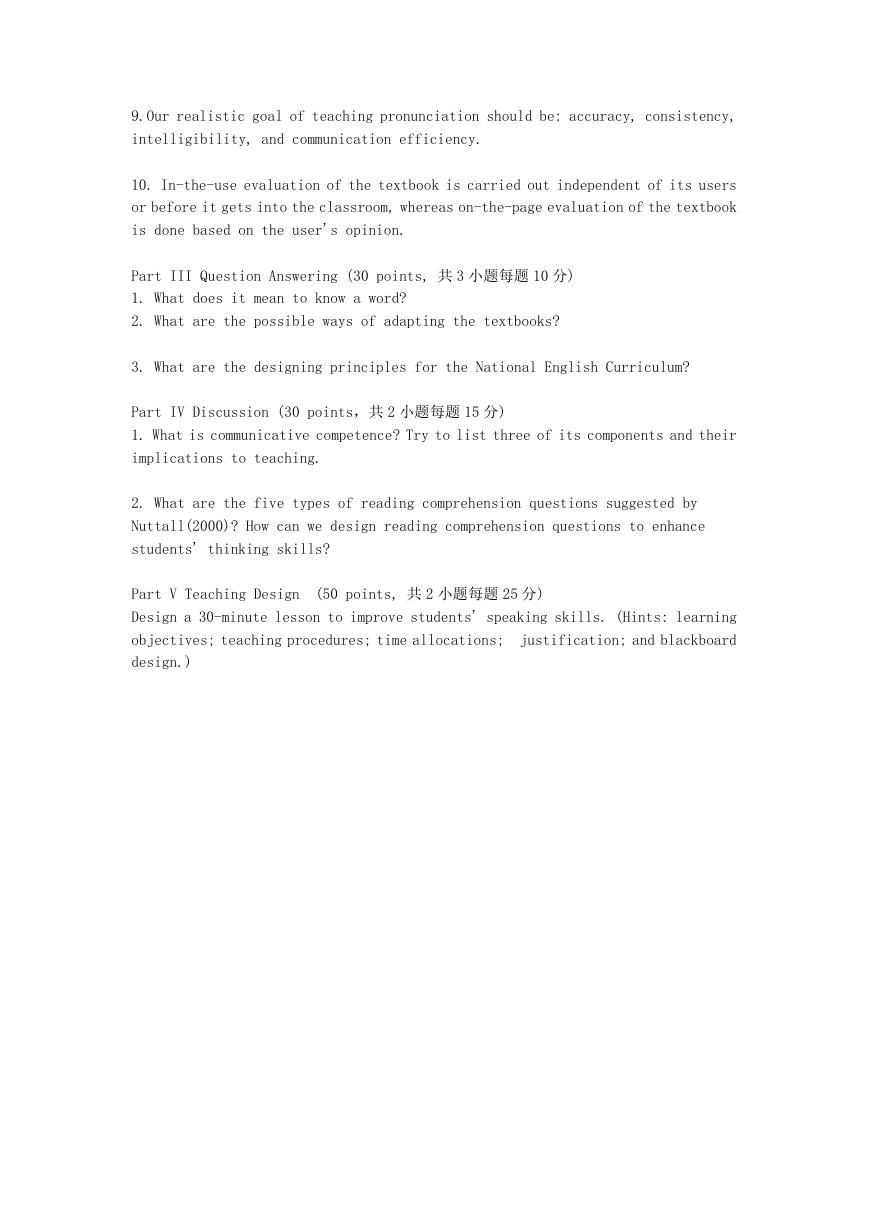2018 年浙江温州大学英语教学法考研真题
Part I Explanation of Terminology (20 points, 共 5 小题每题 4 分)
1.structural view of language
2.information gap
3.silent way
4.deductive method (grammar teaching)
5.reliability (in testing)
Part II Statement Judging (20 points, 共 10 小题每题 2 分)
1.Affective Filter Hypothesis is based on the theory of an affective filter, which
states that successful second language acquisition depends on the learner's feeling.
Negative attitudes are said to act as a filter, preventing the learner from making
use of INPUT, and thus hindering success in language learning.
2.Cognitive style is a particular way in which a learner tries to learn something.
In second or foreign language learning, different learners may prefer different
solutions to learning problems.
3.Discipline in the language classroom refers to a code of conduct which binds a
teacher and a group of students together so that learning can be more effective.
4.Sight vocabulary refers to the words that one is able to immediately recognize
with both sounds and meanings without special effort from the brain.
5.Assimilation is a process in which a group gradually gives up its own language,
culture, and system of values and takes on those of another group with a different
language, culture and system of values, through a period of interaction.
6.Littlewood (1981) divides communicative speaking activities into two types:
information-gap activities and communication activities.
7.Reading comprehension is based on the interactive process between visual
information obtained from the
(of language, of the world, of text types) in interactive reading model.
reading materials and the readers' prior knowledge
8. The main procedures of a process approach to writing include: Creating a
motivation to write; brainstorming; mapping; freewriting; outlining; drafting;
editing; revising; proofreading and conferencing.
�
9.Our realistic goal of teaching pronunciation should be: accuracy, consistency,
intelligibility, and communication efficiency.
10. In-the-use evaluation of the textbook is carried out independent of its users
or before it gets into the classroom, whereas on-the-page evaluation of the textbook
is done based on the user's opinion.
Part III Question Answering (30 points, 共 3 小题每题 10 分)
1. What does it mean to know a word?
2. What are the possible ways of adapting the textbooks?
3. What are the designing principles for the National English Curriculum?
Part IV Discussion (30 points,共 2 小题每题 15 分)
1. What is communicative competence? Try to list three of its components and their
implications to teaching.
2. What are the five types of reading comprehension questions suggested by
Nuttall(2000)? How can we design reading comprehension questions to enhance
students' thinking skills?
(50 points, 共 2 小题每题 25 分)
Part V Teaching Design
Design a 30-minute lesson to improve students' speaking skills. (Hints: learning
objectives; teaching procedures; time allocations;
justification; and blackboard
design.)
�
(English, 8B, Module7 Summer in Los Angeles, Unit 1 Please write to me and send me
photos)
2. Design a 45-minute teaching plan for material. (Hints: learning objectives;
teaching procedures; time allocations; justification; and blackboard design.)
�
(English, 8B, Module 7 Summer in Los Angeles, Unit 2 Fill out our form and come to
learn English in Los Angeles)
�








 2023年江西萍乡中考道德与法治真题及答案.doc
2023年江西萍乡中考道德与法治真题及答案.doc 2012年重庆南川中考生物真题及答案.doc
2012年重庆南川中考生物真题及答案.doc 2013年江西师范大学地理学综合及文艺理论基础考研真题.doc
2013年江西师范大学地理学综合及文艺理论基础考研真题.doc 2020年四川甘孜小升初语文真题及答案I卷.doc
2020年四川甘孜小升初语文真题及答案I卷.doc 2020年注册岩土工程师专业基础考试真题及答案.doc
2020年注册岩土工程师专业基础考试真题及答案.doc 2023-2024学年福建省厦门市九年级上学期数学月考试题及答案.doc
2023-2024学年福建省厦门市九年级上学期数学月考试题及答案.doc 2021-2022学年辽宁省沈阳市大东区九年级上学期语文期末试题及答案.doc
2021-2022学年辽宁省沈阳市大东区九年级上学期语文期末试题及答案.doc 2022-2023学年北京东城区初三第一学期物理期末试卷及答案.doc
2022-2023学年北京东城区初三第一学期物理期末试卷及答案.doc 2018上半年江西教师资格初中地理学科知识与教学能力真题及答案.doc
2018上半年江西教师资格初中地理学科知识与教学能力真题及答案.doc 2012年河北国家公务员申论考试真题及答案-省级.doc
2012年河北国家公务员申论考试真题及答案-省级.doc 2020-2021学年江苏省扬州市江都区邵樊片九年级上学期数学第一次质量检测试题及答案.doc
2020-2021学年江苏省扬州市江都区邵樊片九年级上学期数学第一次质量检测试题及答案.doc 2022下半年黑龙江教师资格证中学综合素质真题及答案.doc
2022下半年黑龙江教师资格证中学综合素质真题及答案.doc